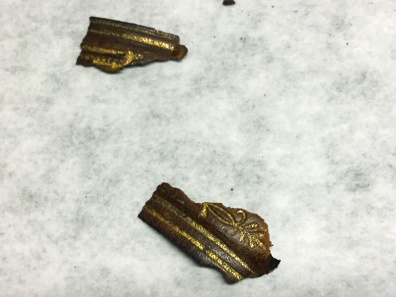Still looking for the before-before pictures. This is a work in progress: a friend’s nice old leather bound copy of Barnaby Rudge. Most of the spine was missing. All that remained was a bit of leather near the head that was not the original spine, but an older repair about half the height of the book. It was still attached to the outside top of the boards. The repair had false raised bands, and the it’s possible that the leather used to make them came from the original spine. You can see the lighter area on the cover leather where some of the patina was removed along with the repair. The repair was attached with paste, I think, and I didn’t want to risk blackening the original leather by moistening the paste, so I removed the material mechanically, and it took the top layer of cells off the leather. It’s not ideal, but it’s better than having the cover turn jet black. Some leather blackens when wet and the change is irreversible.

I believe these small scraps are all that remain of the original spine. There was once some good tooling over the bands, and I will guess that the entire spine was decorated, since there is more than just a simple line below the raised band.

This photo shows the edge gilding, which is on all three sides, as well as a bit of the gold tooling on the leather turn-ins. So much decoration on the insides really makes me think the spine must have been quite ornate.

The cover boards are still attached – barely – with the original lacing. I didn’t want to remove them. The marbled paper inside is broken at the joints, though, and needs repair. I hate to cover up that paper, so I dampened the edges of it enough gently lift a tiny bit of it off the boards on the inside. It turns out the original binder had made a bit of a wrinkle in the paper at the joint, and pasted it down over all the board edges, so I was able to tease quite a bit of it out. I colored a piece of Japanese tissue to match the dominant maroon color. The marble flyleaf was pasted to the first white endsheet for about a half an inch near the joint. I was able to also lift up the edge of this paper, attach the repair paper to the shoulder (and just barely on the first endsheet) and then paste the unfolded marble paper down on top of that. My hope is that once the book has been rebacked, there will be enough of the old marble paper left to nearly cover all the JT repair paper.

This is a close-up of the inside front with a better view of the tooling of the turn-ins, and a booksellers ticket that reads “Myers & Co., 59 High Holborn, London” plus whatever is covered up by the folded up pastedown. Sorry, the book is on another floor and I’m lazy. That’s the back side of the repair tissue. The idea is to eventually paste it down onto the bare board surface, then paste the colored paper back over the top.
Here are the first few pages of the book. No printing date. There is a pasted in newspaper clipping that seems old. I hope there’s enough information to identify the edition, and then perhaps I can locate an original copy and see if the decoration matches this one. That will give me an idea of what the original spine may have looked like. Whether or not I have the skill to tool a fancy spine is another matter.




